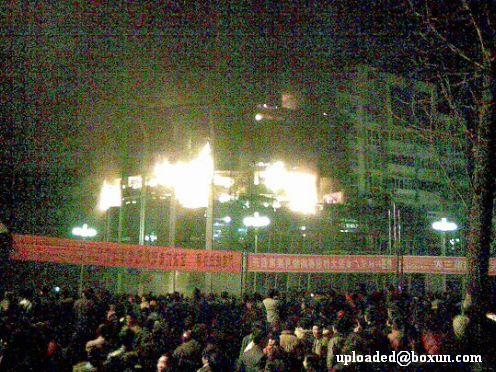China may (or may not) have developed a satellite killer missile, according to Aviation Week:
U. S. intelligence agencies believe China performed a successful anti-satellite (asat) weapons test at more than 500 mi. altitude Jan. 11 destroying an aging Chinese weather satellite target with a kinetic kill vehicle launched on board a ballistic missile…
Although more of a “policy weapon” at this time, the test shows that the Chinese military can threaten the imaging reconnaissance satellites operated by the U. S., Japan, Russia, Israel and Europe.
The article ends with this suggestion as to its possible uses:
The Republic of China also operates a small imaging spacecraft that can photograph objects as small as about 10 ft. in size, a capability good enough to count cruise missiles pointed at Taiwan from the Chinese mainland. The Taiwanese in the past have also leased capability on an Israeli reconnaissance satellite.
In a flash of cuteness, China Daily republished the article without contributing anything new.
China Matters picks up this idea, pointing out that besides Japan and India missile defense plans, the leading missile defense proponents, the United States, could theoretically use missile defense in a Taiwan conflict:
Probably, the whole Missile Defense thing is an effort to knock down the (relatively) strongest leg of the shaky Chinese nuclear deterrent triad, its ICBMs.
And that means China is left without a credible riposte to U.S. use of tactical nuclear weapons to forestall an invasion of Taiwan.
The argument being that taking out recon satellites would leave any missile defense system useless, since they need satellites for targeting and JIT delivery. Personally, I think this takes it all two steps farther than it should. Such a capability would be useful since it could cripple the information gathering power of satellites, whether that data is applied to missile defense, cruise missiles, smart bombs or simply monitoring troop deployments. Going the extra mile of applying it to a Taiwan scenario or, even more of a reach, the use of tactical nukes seems unnecessary and alarmist.
Defense Tech points out
“if this anti-sat weapon was really “kinetic” — i.e., hit-to-kill, non-explosive — instead of a plain ol’ exploding weapon, that’s extremely bad news. That means the booster rocket has to be very accurate “in order to deliver the kill vehicle to the desired initial trajectory…. Then the kill vehicle needs to tweak its trajectory into a precise collision course using on-board propulsion and either on-board target tracking or… command guidance from the ground.” That’s no mean task.”
In other words, it’d be a hell of a technical coup for China. One commenter at Defense Tech, Satellite Pete, has a nice comment pointing out:
Sinosat-2, the first of a new series of jamming-resistant satellites which emerged in 2002 after the Falun Gong jamming episodes, reminds us that China probably must be quite fearful that through some creative plotting, a significant disruption of Olympics coverage might occur, involving satellite feeds and sliced fiber optic cables or both.
The US and its allies have issued a statement of concern, but its not clear what exactly has happened. I’m going to keep my eye on ArmsControlWonk Jeffrey Lewis – he’s watching the satellite data and will most likely be blogging about any debris clouds. If it is a kill rocket, though, I’m with Satellite Pete: why would China cause a ruckus with a test like this now?
UPDATE: ArmsControlWonk weighs in, noting that the debris cloud is “a god awful mess” and that US ASAT (anti-satellite) programs were scrapped exactly because of this debris, which could damage other satellites (US ones). Defense Tech also has numerous details, including John Pike of Globalsecurity.org expecting more tests as China perfects the technology. Won’t creating more space garbage be a hazard to China’s future satellites? If it really is a hazard to other space vehicles, isn’t China just increasing the chance that their moon shot is scrambled by one of 2 million mm thick fragments? I’m with Jeffrey on this one: the whole thing seems stupid and pointless.
UPDATE 2
ArmsControlWonk points out Japan and Australia are demanding explanations from the Chinese government. They seem more worked up, and I wonder if this is because, as Defense Tech points out, “this test demonstrates the capability to achieve a velocity error on the order of 3 meters / ~1000 seconds, i.e., way less than 1 cm per second. This has obvious implications for their CEPs [Circular Error Probables, the accuracy] of Chinese ballistic missiles.” So this means China’s ballistic missiles are more accurate than perhaps previously believed, whether shooting at satellites (this one had a course correction, so they cheated a little) or at ground targets. James Oberg, a 22 year Mission Control veteran, writes at MSNBC about the technical and the political. The US has avoided a space weapon ban treaty and China is probably using this to demand one. Unfortunately, since “outer space” is tough to define and there can be dual-purpose satellites (GPS, for one), its hard to imagine how a treaty could be written and work. A common theme these articles share I’ll repeat is that there’s no arms race here, though that framing will likely persist. Countermeasures are extraordinarily difficult to make effective, and shooting down Chinese satellites just won’t be eye for an eye. More like toenail for a leg, since China has an asymmetric advantage here. The US could flood the sky with auxillary and decoy satellites, but when you’re talking about something like GPS I don’t see how you could make the signal identifiable to one side and not the other. Even if the US floods the skies with space weapons, it’s hard to imagine China matching the US tit-for-tat like a true arms race. It isn’t hard to see them developing asymmetric ways to disable US space weapons like this one, but that would be purely defensive, as opposed to Chinese weapons orbiting US territory.
On the other side of the Pacific, the US Navy now has a friggin’ real-life rail gun. Like “hitting a target with a Ford Taurus at 380 mph”. The Chinese rail-gun is expected to hit a target like a Chery at 100 kph.
Sorry, Dave, but please don’t open new entries so soon after the first. Raj


Comments